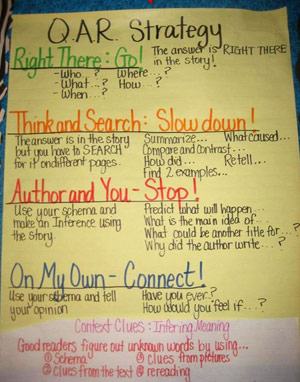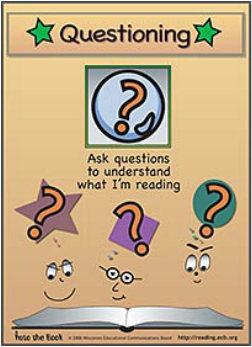What is Questioning?
According to Into the Book (2015), questioning is when readers ask questions about the text and the author's intentions, and seek information to clarify and extend their thinking before during and after reading. In other words, good readers ask themselves questions to help them understand and comprehend what they read. Questioning is a comprehension strategy. When students generate and answer questions, it helps them think about their text and beyond it as well. This strategy is higher up on Blooms Taxonomy because it requires students to be creative and come up with questions on their own challenging them to use higher-level thinking skills (Reading Rockets: QAR). There are 4 different types of questions that students should be aware of when reading. Through Reading Rockets research, the following is a list and explanation of each type of question:
- Right There Questions: These types of questions are questions that can be found directly in the text. Usually, the words used in the question are taken directly from the text.
- Example: Who? What? When? Where? Why? How?
- Think and Search Questions: These types of questions are generated from several parts of the text and put together to make meaning.
- Example: Compare and contrast... Summarize... What Caused...
- Author and You: These types of questions are based on information provided in the text, but the student should relate the question to their own life.
- What could be another title? Predict what will happen...?
- On My Own: These types of questions do not require the student to read the text. The students will need to use their schema to answer these types of questions.
- Have you ever...? How would you feel if...?
Visual Representation
Content Area Examples
Math- Questioning could be adapted in a math lesson by having the students read over the unit chapter. If the students come across something they are confused about, they may want to write down or think of a question to ask the teacher. Once the students are finished reading, the teacher will go through the unit with the students. As the teacher goes through the lesson, the students will write down the answers to their questions. At the end, if some questions did not get answered, then the teacher will clarify those questions.
Science- This comprehension strategy could be adapted in a science lesson by the teacher doing a read aloud about a scientist. As the teacher reads the story, the students may generate questions. They may have questions that are directly from the text or questions from the text that relate to their own life. Asking and answering questions before, during, and after reading, helps students deepen their understanding of what they read.
History- The strategy could be adapted in a History lesson by the teacher doing a read aloud from a history book. As the teacher reads, the students should generate and write down questions they have about the story. the questions could be clarifying questions, as well as questions the students generated from their schema. Once the teacher finishes reading, the teacher may call on students to share their questions with the class.
Reading- This strategy is incorporated in reading almost every day. Good readers ask questions as they read. If they do not understand a part in their book, they should write it down as a question. If a student doesn't know a word, then they should write it down, and look it up in the dictionary. Creating and answering different type of questions helps increase students comprehension through higher-level thinking skills.
Science- This comprehension strategy could be adapted in a science lesson by the teacher doing a read aloud about a scientist. As the teacher reads the story, the students may generate questions. They may have questions that are directly from the text or questions from the text that relate to their own life. Asking and answering questions before, during, and after reading, helps students deepen their understanding of what they read.
History- The strategy could be adapted in a History lesson by the teacher doing a read aloud from a history book. As the teacher reads, the students should generate and write down questions they have about the story. the questions could be clarifying questions, as well as questions the students generated from their schema. Once the teacher finishes reading, the teacher may call on students to share their questions with the class.
Reading- This strategy is incorporated in reading almost every day. Good readers ask questions as they read. If they do not understand a part in their book, they should write it down as a question. If a student doesn't know a word, then they should write it down, and look it up in the dictionary. Creating and answering different type of questions helps increase students comprehension through higher-level thinking skills.


